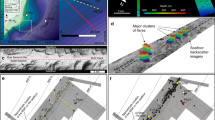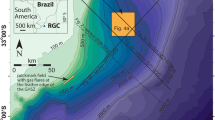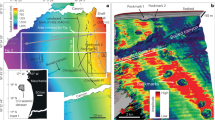Abstract
The Gulf Stream is an ocean current that modulates climate in the Northern Hemisphere by transporting warm waters from the Gulf of Mexico into the North Atlantic and Arctic oceans1,2. A changing Gulf Stream has the potential to thaw and convert hundreds of gigatonnes of frozen methane hydrate trapped below the sea floor into methane gas, increasing the risk of slope failure and methane release3,4,5,6,7,8,9. How the Gulf Stream changes with time and what effect these changes have on methane hydrate stability is unclear. Here, using seismic data combined with thermal models, we show that recent changes in intermediate-depth ocean temperature associated with the Gulf Stream are rapidly destabilizing methane hydrate along a broad swathe of the North American margin. The area of active hydrate destabilization covers at least 10,000 square kilometres of the United States eastern margin, and occurs in a region prone to kilometre-scale slope failures. Previous hypothetical studies3,5 postulated that an increase of five degrees Celsius in intermediate-depth ocean temperatures could release enough methane to explain extreme global warming events like the Palaeocene–Eocene thermal maximum (PETM) and trigger widespread ocean acidification7. Our analysis suggests that changes in Gulf Stream flow or temperature within the past 5,000 years or so are warming the western North Atlantic margin by up to eight degrees Celsius and are now triggering the destabilization of 2.5 gigatonnes of methane hydrate (about 0.2 per cent of that required to cause the PETM). This destabilization extends along hundreds of kilometres of the margin and may continue for centuries. It is unlikely that the western North Atlantic margin is the only area experiencing changing ocean currents10,11,12; our estimate of 2.5 gigatonnes of destabilizing methane hydrate may therefore represent only a fraction of the methane hydrate currently destabilizing globally. The transport from ocean to atmosphere of any methane released—and thus its impact on climate—remains uncertain.
This is a preview of subscription content, access via your institution
Access options
Subscribe to this journal
Receive 51 print issues and online access
$199.00 per year
only $3.90 per issue
Buy this article
- Purchase on Springer Link
- Instant access to full article PDF
Prices may be subject to local taxes which are calculated during checkout



Similar content being viewed by others
References
Lynch-Stieglitz, J., Curry, W. & Slowey, N. Weaker Gulf Stream in the Florida Straits during the Last Glacial Maximum. Nature 402, 644–648 (1999)
Lynch-Stieglitz, J., Schmidt, M. W. & Curry, W. Evidence from the Florida Straits for Younger Dryas ocean circulation changes. Paleoceanography 26, PA1205, https://doi.org/10.1029/2010PA002032 (2011)
Winguth, A., Shellito, C., Shields, C. & Winguth, C. Climate response at the Paleocene-Eocene Thermal Maximum to greenhouse gas forcing — a model study with CCSM3. J. Clim. 23, 2562–2584 (2010)
Dickens, G. R. The potential volume of oceanic methane hydrates with variable external conditions. Org. Geochem. 32, 1179–1193 (2001)
Hornbach, M. J., Saffer, D. M. & Holbrook, W. S. Critically pressured free-gas reservoirs below gas-hydrate provinces. Nature 427, 142–144 (2004)
Kennett, J. P., Cannariato, K. G., Hendy, I. L. & Behl, R. J. Methane Hydrates in Quaternary Climate Change: The Clathrate Gun Hypothesis (Spec. Publ. Ser. Vol. 54, American Geophysical Union, 2003)
Biastoch, A. et al. Rising Arctic Ocean temperatures cause gas hydrate destabilization and ocean acidification. Geophys. Res. Lett.. 38, L08602, https://doi.org/10.1029/2011GL047222 (2011)
Archer, D. et al. The importance of ocean temperature to global biogeochemistry. Earth Planet. Sci. Lett. 222, 333–348 (2004)
Flemings, B. P., Liu, X. & Winters, W. J. Critical pressure and multiphase flow in Blake Ridge gas hydrates. Geology 31, 1057–1060 (2003)
Deser, C. & Blackmon, M. L. Surface climate variations over the North Atlantic Ocean during winter: 1900–1989. J. Clim. 6, 1743–1753 (1993)
Evans, H. K., Hall, I. R., Bianchi, G. G. & Oppo, D. W. Intermediate water links to Deep Western Boundary Current variability in the subtropical NW Atlantic during marine isotope stages 5 and 4. Paleoceanography 22, PA3209, https://doi.org/10.1029/2006PA001409 (2007)
Wu, L. et al. Enhanced warming over the global subtropical western boundary currents. Nature Clim. Change 2, 161–166 (2012)
Kvenvolden, K. A. Gas hydrates: geological perspective and global change. Rev. Geophys. 31, 173–187 (1993)
Milton, D. J. in The Future Supply of Nature-Made Gas (ed. Meyer, R. F. ) 927–943 (Technical Reports, Pergamon, 1976)
Shipley, T. H. et al. Seismic evidence for widespread possible gas hydrate horizons on continental slopes and rises. Bull. Am. Assoc. Petrol. Geol. 63, 2204–2213 (1979)
Holbrook, W. S., Hoskins, H., Wood, W. T., Stephen, R. A. & Lizarralde, D. Methane hydrate and free gas on the Blake Ridge from vertical seismic profiling. Science 273, 1840–1843 (1996)
Yamano, M., Uyeda, S., Aoki, Y. & Shipley, T. H. Estimates of heat flow derived from gas hydrates. Geology 10, 339–343 (1982)
Lund, D., Lynch-Stieglitz, J. & Curry, W. Gulf Stream density structure and transport during the past millennium. Nature 444, 601–604 (2006)
Ruppel, C. D. Anomalously cold temperatures observed at the base of the gas hydrate stability zone on the US Atlantic passive margin. Geology 25, 699–702 (1997)
Ruppel, C. D., Von Herzen, R. P. & Bonneville, A. Heat flux through an old (∼175 Ma) passive margin: offshore southeastern United States. J. Geophys. Res. 100 (B10). 20037–20057 (1995)
Dillon, W. P., Lee, M. W., Fehlhaber, K. & Coleman, D. F. Gas hydrates on the Atlantic margin of the United States — controls on concentration. US Geol. Surv. Prof. Pap. 1570, 313–330 (1993)
Carpenter, G. Coincident sediment slump/clathrate complexes on the U.S. Atlantic continental slope. Geo-Mar. Lett. 1, 29–32 (1981)
Paull, C. K., Matsumoto, R. & Wallace, P. J. Gas hydrate sampling on the Blake Ridge and Carolina Rise. Proc. ODP Init. Rep.. 164, 5–12, https://doi.org/10.2973/odp.proc.ir.164.1996 (1996)
Sloan, E. D. & Koh, C. A. Clathrate Hydrates of Natural Gases 3rd edn (CRC Press, 2008)
Dugan, B. & Fleming, P. B. Overpressure and fluid flow in the New Jersey continental slope: implications for slope failures and cold seeps. Science 289, 288–291 (2000)
Hutchison, I. The effects of sedimentation and compaction on oceanic heat flow. Geophys. J. R. Astron. Soc. 82, 439–459 (1985)
Westbrook, G. K. et al. Escape of methane gas from the seabed along the West Spitsbergen continental margin. Geophys. Res. Let.. 36, L15608, https://doi.org/10.1029/2009GL039191 (2009)
Rajan, A. Mienert, J. & Bünz, S. Acoustic evidence for a gas migration and release system in Arctic glaciated continental margins offshore NW-Svalbard. Mar. Petrol. Geol. 32, 36–49 (2012)
Bryan, G. M., Markl, R. G. & Sheridan, R. E. IPOD site survey in the Blake-Bahamas Basin. Mar. Geol. 35, 43–63 (1980)
Mackenzie, K. V. Discussion of seawater sound-speed determinations. J. Acoust. Soc. Am. 70, 801–806 (1981)
Acknowledgements
We thank L. Gahagan and the UTIG Marine Seismic Data Center for providing access to seismic line 80.A.
Author information
Authors and Affiliations
Contributions
B.J.P. performed all experimental work integrating seismic lines and CTD temperature data into 2D thermal models and the hydrate stability model. M.J.H. conceived the work and developed and tested the prototype 2D models. Both authors worked together to refine the model, analyse data, interpret results, write the manuscript and create the figures.
Corresponding author
Ethics declarations
Competing interests
The authors declare no competing financial interests.
Supplementary information
Supplementary Figure
This file contains a Supplementary Figure. (PDF 867 kb)
Supplementary Table
This table depicts the depth of the sea floor and BSR at each shot location (with each shot spaced ~70 m apart). We calculated the error in seafloor and BSR depth using end member P-wave seismic velocities derived from CTD casts and semblance analysis of common-mid-point seismic gathers collected on the Blake Ridge. (XLS 119 kb)
Rights and permissions
About this article
Cite this article
Phrampus, B., Hornbach, M. Recent changes to the Gulf Stream causing widespread gas hydrate destabilization. Nature 490, 527–530 (2012). https://doi.org/10.1038/nature11528
Received:
Accepted:
Published:
Issue Date:
DOI: https://doi.org/10.1038/nature11528
This article is cited by
-
Submarine slope failures due to gas hydrate dissociation and degassing along the edge of gas hydrate stability zone in the Krishna Godavari basin
Natural Hazards (2024)
-
Evidence of Arctic methane emissions across the mid-Pleistocene
Communications Earth & Environment (2023)
-
The influence of climate change, green innovation, and aspects of green dynamic capabilities as an approach to achieving sustainable development
Environmental Science and Pollution Research (2023)
-
Influence of methane seepage on isotopic signatures in living deep-sea benthic foraminifera, 79° N
Scientific Reports (2022)
-
Deglacial bottom water warming intensified Arctic methane seepage in the NW Barents Sea
Communications Earth & Environment (2021)
Comments
By submitting a comment you agree to abide by our Terms and Community Guidelines. If you find something abusive or that does not comply with our terms or guidelines please flag it as inappropriate.



